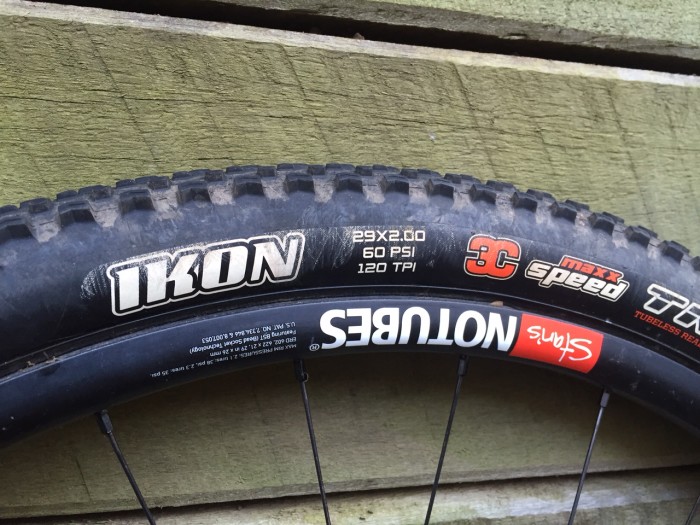The Maxxis Ikon is currently synonymous with XC and XCM racing. Along with the Schwalbe Racing Ralph, the Ikon tread pattern is in favour with many endurance based riders and racers. Like the Hutchinson Python, Kenda Small Block 8 and Specialized Fast Trak and others over the years, the Ikon rolls fast and has predictable, if not copious, amounts of grip.
With a few casing options available, many favour the 2.2″ Maxxis Ikon with the reinforced EXO casing with 3C rubber and Tubeless Ready (TR) bead. The 2.2″ width is on the narrower sides of 2.2″, but the EXO reinforcement provides fantastic insurance against flats for about 60g more than the standard Exception casing. The 3C triple rubber compound wears well and is quite grippy without being squirmy, and the TR bead does help the tyre inflate on some rim models that aren’t otherwise as tubeless friendly. That combo is now about 640g – but oh so reliable.
It’s not really a significant weight saving – so where is the advantage?
But sometimes, it’s a bit too much tyre. While the Maxxis Ikon does have a fairly narrow performance window, few racers are likely to switch it out for a mud tyre, or something with deep tread if a course has a few sections of loamy trail. More riders are also starting to use dual-suspension bikes, so having an Ikon that perhaps had a little more clearance through a frame in wet conditions, or just dropped some weight on the back end of a dual suspension bike is a good idea.
The 2.2″ Ikon on the left is noticeably wider than the 2.0″ Ikon on the right.
Take a look at top racers and you’ll see they follow suit – Dan McConnell and Brendan Johnston had narrower rear tyres on their Trek dual suspension bikes at the Australian XCO Championships in 2015 (and it looks like Johnston did when winning the XCM Championships in May). Christoph Sauser raced the 2015 Cape Epic on 1.95″ tyres – trusting in his bikes suspension to do the work.
An extended Maxxis Ikon family
Enter the 2.0″ Maxxis Ikon, with the same EXO/TR/3C option (although other options are also available). The weight doesn’t drop much – about 40g per tyre. And the size is noticeably smaller. Of note, Maxxis also make a 2.35″ Ikon for those who really want the bag size.
After some brief rides running the tyres front and rear, I ended up using the 2.0 Ikon just on the back, with a 2.2″ Ardent Race up front. That combination is just so versatile, it’s hard to move away from for too long.
The smaller tyre did seem to accelerate a little better, and when running one on the front, the steering really felt a lot lighter. Of course, many of these impressions are while riding around the street outside the garage. On the trail, it was a little more muted.
That said, the 2.0 Ikon made the bike lively, and nice and quick to change direction. But maybe a bit less confident in off camber corners, and with a little more reliance on small bump sensitivity from your suspension. If you’re after something to get a small gain, this could be a good option – it had more traction than the Maxxis Tread-Lite, and the weight is about the same.
Going back to a 2.2″ Ikon on the rear was noticeable, mainly as my bike felt more sure-footed, especially cornering on looser surfaces and at speed. But if I was heading to a wet race, or something with a lot of hardpack or firetrail, I’d really consider the 2.0 Ikon front and rear. As it is, I do opt for the 2.0 Ikon on the rear for races that aren’t overly loose or rocky.

